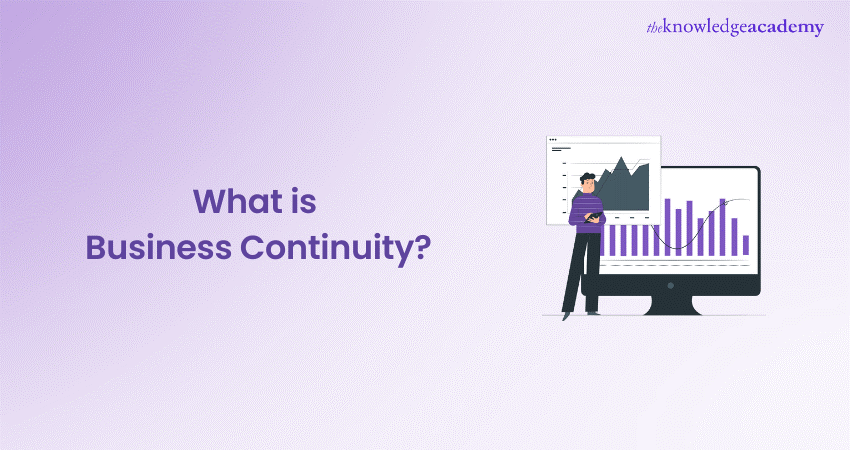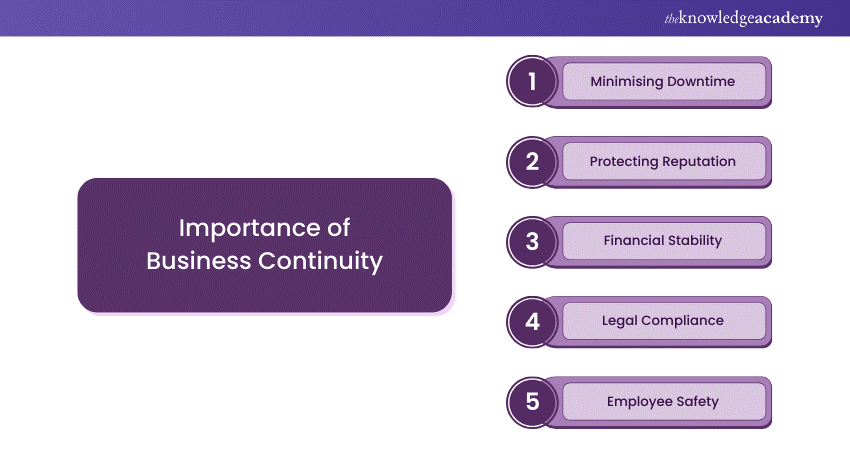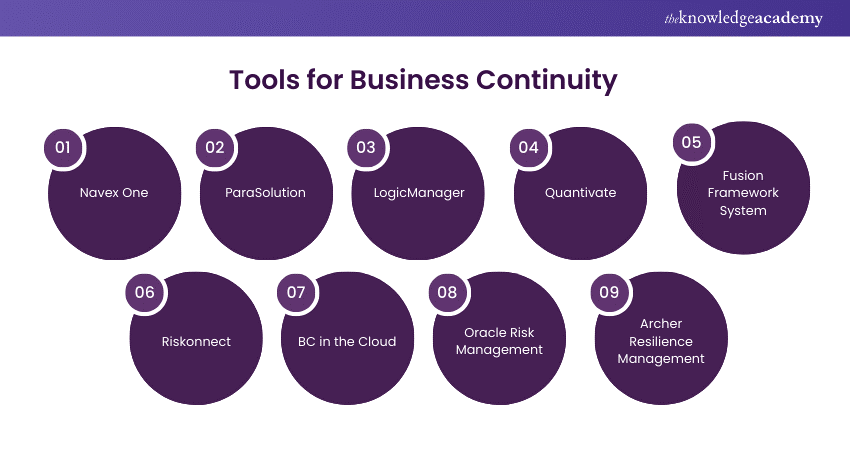We may not have the course you’re looking for. If you enquire or give us a call on +27 800 780004 and speak to our training experts, we may still be able to help with your training requirements.
Training Outcomes Within Your Budget!
We ensure quality, budget-alignment, and timely delivery by our expert instructors.

How can businesses stay prepared for unexpected disruptions? What is Business Continuity, and why is it so important? It's all about ensuring that essential functions keep running smoothly during and after a disaster. This blog explores the significance of Business Continuity, diving into key components like resilience, recovery, and contingency planning.
Discover the tools and strategies that help businesses protect their operations and maintain trust with customers. Ready to find out how your business can weather any storm? Read on to learn more!
Table of Contents
1) What is Business Continuity?
2) The Importance of Business Continuity
3) Key Components of a Business Continuity Plan
4) Essential Tools for Business Continuity
5) Difference Between Business Continuity and Disaster Recovery
6) Conclusion
What is Business Continuity?
Business Continuity refers to an organisation's ability to maintain essential functions during and after a disaster or disruption. It ensures that critical operations can continue, minimising the impact on the business. This could involve natural disasters, cyberattacks, or any other unexpected events that threaten to disrupt normal business activities.
A Business Continuity Plan (BCP) is a strategic framework that outlines the instructions an organisation must follow in the face of such disruptions. It includes detailed steps to take before, during, and after an event to ensure the continuity of operations.
The Importance of Business Continuity
Having a Business Continuity plan is crucial for several reasons:

a) Minimising Downtime: Disruptions can bring business operations to a halt. A well-prepared plan helps minimise downtime and keep essential services running.
b) Protecting Reputation: Companies that handle disruptions smoothly are seen as reliable. This helps maintain customer trust and brand reputation.
c) Financial Stability: Extended downtime can lead to significant financial losses. By ensuring operations continue, businesses can protect their revenue streams.
d) Legal Compliance: Some industries have regulations that require Business Continuity Plans. Compliance with these regulations avoids legal penalties and enhances operational security.
e) Employee Safety: A comprehensive plan ensures that employees know what to do during a disruption, prioritising their safety and well-being.
Key Components of a Business Continuity Plan
A Business Continuity plan consists of several key components:
Resilience
Resilience refers to an organisation's ability to absorb shocks and continue operating. Building resilience involves:
a) Redundancy: Having backup systems and resources in place to take over if primary ones fail.
b) Training and Awareness: Ensuring employees are trained on the procedures to follow during disruptions.
c) Technology: Implementing robust IT systems that can withstand disruptions, including cloud solutions and data backups.
Recovery
Recovery focuses on restoring business operations to normal after a disruption. Key elements include:
a) Recovery Time Objectives (RTO): Setting targets for how quickly operations should be restored.
b) Recovery Point Objectives (RPO): Determining the acceptable amount of data loss measured in time.
c) Recovery Strategies: Develop specific strategies for different types of incidents, such as natural disasters or online attacks.
Contingency
Contingency planning involves preparing for the unexpected. This includes:
a) Alternative Work Locations: Identifying backup locations where employees can work if primary offices are inaccessible.
b) Emergency Communication Plans: Establishing methods for communicating with employees, customers, and stakeholders during a disruption.
c) Supply Chain Management: Ensuring that alternative suppliers are available if primary ones are affected.
Learn about the implementation of Business Continuity with our ISO 22301 Lead Implementer Course – Join today!
Essential Tools for Business Continuity
Business continuity is crucial for ensuring that your operations can withstand and recover from disruptions. Here are some essential tools that can help:

a) Navex One: This platform offers a comprehensive suite of risk and compliance management tools. It helps organisations ensure Business Continuity by addressing various compliance and risk management needs.
b) ParaSolution: Known for its robust Business Continuity planning features, ParaSolution helps organisations prepare for and respond to disruptions. It offers tools for creating, managing, and testing Business Continuity plans.
c) LogicManager: LogicManager simplifies governance, risk, and compliance processes. It provides a centralised platform for managing risks and ensuring Business Continuity through effective planning and response.
d) Quantivate: Quantivate offers integrated tools for streamlining Business Continuity management. It helps organisations develop, implement, and maintain effective Business Continuity plans.
e) Fusion Framework System: This system redefines resilience with its comprehensive features for Business Continuity management. It enables organisations to manage risks, incidents, and recovery processes efficiently.
f) Riskonnect: Formerly known as Castellan Solutions, Riskonnect provides a roadmap to business resiliency. It offers tools for risk management, incident response, and business continuity planning.
g) BC in the Cloud: BC in the Cloud enables efficient crisis management and Business Continuity planning. It offers a cloud-based platform for managing Business Continuity plans and responding to incidents.
h) Oracle Risk Management: A trusted name in Business Continuity, Oracle Risk Management provides tools for managing risks and ensuring operational continuity. It helps organisations identify, assess, and mitigate risks effectively.
i) Archer Resilience Management: Archer Resilience Management ensures operational continuity through comprehensive risk and Business Continuity management features. It helps organisations prepare for, respond to, and recover from disruptions.
Difference Between Business Continuity and Disaster Recovery
While Business Continuity and Disaster Recovery are related, they are not the same. Business Continuity maintains essential functions during and after a disruption. It encompasses the overall strategy and planning to keep operations running.
Disaster Recovery, on the other hand, is a subset of Business Continuity. It specifically deals with restoring IT systems and data after a disruption. Disaster Recovery plans outline the steps to recover data, applications, and technology infrastructure to resume normal operations.
Ultimately, Business Continuity is about keeping the business running, while Disaster Recovery focuses on restoring IT systems after an interruption.
Learn Business Continuity with our ISO 22301 Certified Business Continuity Management Course – Join today!
Conclusion
Understanding "What is Business Continuity" is crucial for any organisation to withstand disruptions and maintain smooth operations. By implementing the key components of a Business Continuity plan, businesses can minimise downtime, protect their reputation, and ensure financial stability. Using essential tools and technologies strengthens these efforts. Investing in a comprehensive plan builds trust with customers, employees, and stakeholders, ensuring long-term success and stability.
Learn to develop your own Business Continuity programme with our Certified Business Continuity Management Professional (CBCMP) Course – Join today!
Frequently Asked Questions

The 4 P's of Business Continuity Planning (BCP) are People, Processes, Premises, and Providers. These elements ensure that all aspects of the business are covered in the continuity plan.

The BCP process involves identifying potential risks, creating strategies to address risks, and developing a plan to maintain operations during disruptions. It also includes regular testing and updating of the plan to ensure its effectiveness.

The Knowledge Academy takes global learning to new heights, offering over 30,000 online courses across 490+ locations in 220 countries. This expansive reach ensures accessibility and convenience for learners worldwide.
Alongside our diverse Online Course Catalogue, encompassing 17 major categories, we go the extra mile by providing a plethora of free educational Online Resources like News updates, Blogs, videos, webinars, and interview questions. Tailoring learning experiences further, professionals can maximise value with customisable Course Bundles of TKA.

The Knowledge Academy’s Knowledge Pass, a prepaid voucher, adds another layer of flexibility, allowing course bookings over a 12-month period. Join us on a journey where education knows no bounds.

The Knowledge Academy offers various Business Continuity Training, including the Certified Business Continuity Management Professional (CBCMP) Course and ISO 22301 Certified Business Continuity Management Course. These courses cater to different skill levels, providing comprehensive insights into Business Resilience vs Business Continuity.
Our Business Improvement Blogs cover a range of topics related to Business Continuity, offering valuable resources, best practices, and industry insights. Whether you are a beginner or looking to advance your Business Continuity knowledge, The Knowledge Academy's diverse courses and informative blogs have got you covered.
Upcoming Business Improvement Resources Batches & Dates
Date
 Certified Business Continuity Management Professional (CBCMP)
Certified Business Continuity Management Professional (CBCMP)
Mon 13th Jan 2025
Mon 28th Apr 2025
Mon 11th Aug 2025
Mon 10th Nov 2025







 Top Rated Course
Top Rated Course



 If you wish to make any changes to your course, please
If you wish to make any changes to your course, please


